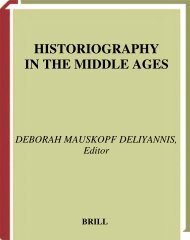Festive Satire: Julian's Misopogon and the New ... - Julian Emperor
Festive Satire: Julian's Misopogon and the New ... - Julian Emperor
Festive Satire: Julian's Misopogon and the New ... - Julian Emperor
Create successful ePaper yourself
Turn your PDF publications into a flip-book with our unique Google optimized e-Paper software.
Who needs <strong>the</strong> Golden Age? Ours is bejewelled-but Neronian.99 MAUD W. GLEASONIn 306 <strong>the</strong> Council of Elvira condemned those who took such liberties with churches: 'Hiqui inventi fuerint libellos famosos in ecclesia ponere, ana<strong>the</strong>matizantur'.~~~ Basil ofCaesarea had to deal with <strong>the</strong> case of a nun whose acquaintance with an unscrupulous manhad ruined her reputation. 'He came to such a pitch of impiety <strong>and</strong> insolence', she wrote,'that he filled <strong>the</strong> whole city with sl<strong>and</strong>ers against me, <strong>and</strong> pilloried me with a publicplacard that was affixed to <strong>the</strong> doors of <strong>the</strong> church'.'"' A century later, when Gothic troopsbilleted in Edessa maltreated <strong>the</strong> citizens, 'those who were ill-disposed among <strong>the</strong>Edessenes dared to do something unseemly; for <strong>the</strong>y wrote down on sheets of paper(xap-rqS) complaints against <strong>the</strong> Magister Militum, <strong>and</strong> fastened <strong>the</strong>m up secretly in <strong>the</strong>customary places of <strong>the</strong> city'.'"" (The Magister responded by packing up his troops <strong>and</strong>leaving town.) Such practices continued in Byzantine times. John of Ephesus preserves <strong>the</strong>amusing story of how a monument under construction by Justin I1 unexpectedly acquiredan unflattering inscription. '"3Imperial edicts, criticizing <strong>the</strong> behaviour of individuals or entire populations, couldprovide an officially posted counterpart to <strong>the</strong> graffiti of private parties. For example,Marcus Aurelius did not massacre <strong>the</strong> supporters of Cassius, '<strong>and</strong> even went so far as topardon <strong>the</strong> citizens of Antioch, who had said many things in support of Cassius <strong>and</strong> inopposition to himself. But he did abolish <strong>the</strong>ir games <strong>and</strong> public meetings, includingga<strong>the</strong>rings of every kind, <strong>and</strong> issued a very severe edict against <strong>the</strong> peopleI suggest that <strong><strong>Julian</strong>'s</strong> posting of <strong>the</strong> <strong>Misopogon</strong> belongs to a traditional pattern ofimperial public behaviour: <strong>the</strong> promulgation of what might be called 'edicts of chastisement'.Fronto considered it <strong>the</strong> emperor's duty to write such things. <strong>Emperor</strong>s ought to'repress by <strong>the</strong>ir edicts <strong>the</strong> faults of provincials, give praise to good actions, quell <strong>the</strong>seditious <strong>and</strong> terrify <strong>the</strong> fierce ones. All <strong>the</strong>se are assuredly things to be achieved by words<strong>and</strong> letters'.'"~ Edicts were technically expressions of <strong>the</strong> emperor's views, <strong>and</strong> unlike libelli<strong>and</strong> subscriptiones were not written as replies to an initiative from below. From <strong>the</strong> time ofConstantine imperial letters came to have <strong>the</strong> force of edicts <strong>and</strong> were often posted up(proposita) in <strong>the</strong> same way.lo6 Edicts were initially published by posting <strong>the</strong>m up at <strong>the</strong>emperor's current place of residence.107 The <strong>Misopogon</strong>, according to ma la la^,^^^ was putup 'outside <strong>the</strong> palace, on <strong>the</strong> so-called Tetrapylon of <strong>the</strong> Elephants near <strong>the</strong> royal street'that served as <strong>the</strong> propylaea of <strong>the</strong> palace.1~9 It is pointless to ask whe<strong>the</strong>r those whocraned <strong>the</strong>ir necks around <strong>the</strong> Tetrapylon of <strong>the</strong> Elephants thought <strong>the</strong>y were reading anedict or an imperial letter. By this time <strong>the</strong> generic distinction had blurred. Any attempt todecide <strong>the</strong> question on <strong>the</strong> basis of formal considerations will tend toward <strong>the</strong> conclusionthat <strong>the</strong> <strong>Misopogon</strong> is a hybrid.lzo Though posted like an edict, it does not begin with Myaior <strong>the</strong> equivalent, it is written in <strong>the</strong> first <strong>and</strong> not in <strong>the</strong> third person, <strong>and</strong> it ends with a99 Sidonius Apollinaris, Ep. v. 8. 2. l0q Lib., Or. XI. 205. It is not quite accurate to say,Canon 52. Compare <strong>the</strong> famosa epistula against with Downey (Antioch, 394 n. 8g), 'The Tetrapylon ofMaxentius that got a Carthaginian deacon into trouble <strong>the</strong> Elephants is not mentioned elsewhere <strong>and</strong> it is not(Optatus I. 17).clear from this passage whe<strong>the</strong>r or not it stood at <strong>the</strong>Basil, ktter 289.crossing of <strong>the</strong> four main streets of <strong>the</strong> isl<strong>and</strong>'. SurelyW. Wright, The Chronicle of roshua <strong>the</strong> Stylite Lib., Or. XI. 204 describes a monument at this intersec-(1882, repr. 1968), 73. Contrast <strong>the</strong> discreet 'suggestion tion: 'From four arches which are joined to each o<strong>the</strong>rbox' for informers' complaints set up outside his palace in <strong>the</strong> shape of a rectangle, four pairs of stoas proceed asby <strong>the</strong> governor Alex<strong>and</strong>er (ch. 29).from an omphalos'.1.3 HE III. 24. Even in classical times non-judicial edicts varied in'04 HA. Marcus xxv. style <strong>and</strong> content. A recent treatment of <strong>the</strong> subject,~sAdM. Antoninum de eloquerztia 2. 7, quoted in emphasizes <strong>the</strong> influence of rhetoric: M. Benner, TheMillar, op. cit. (n. 7), 203.<strong>Emperor</strong> says: Studies in <strong>the</strong> Rhetorical style in Edicts'06 Millar, 319-21 ; 592; 598. of <strong>the</strong> Early Empire, Studia Graeca et Latina1.7 Millar, 254, with references. Gothoburgensia 33 (1975), 190-1.'"8 328. 3-4.













